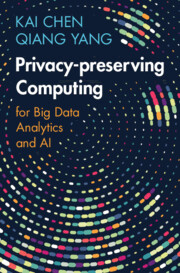Refine search
Actions for selected content:
3312 results in Artificial Intelligence and Natural Language Processing
5 - Oblivious Transfer
-
- Book:
- Privacy-preserving Computing
- Published online:
- 26 October 2023
- Print publication:
- 16 November 2023, pp 69-79
-
- Chapter
- Export citation
2 - Secret Sharing
-
- Book:
- Privacy-preserving Computing
- Published online:
- 26 October 2023
- Print publication:
- 16 November 2023, pp 13-35
-
- Chapter
- Export citation
Frontmatter
-
- Book:
- Privacy-preserving Computing
- Published online:
- 26 October 2023
- Print publication:
- 16 November 2023, pp i-iv
-
- Chapter
- Export citation
9 - Privacy-preserving Computing Platforms
-
- Book:
- Privacy-preserving Computing
- Published online:
- 26 October 2023
- Print publication:
- 16 November 2023, pp 150-193
-
- Chapter
- Export citation
1 - Introduction to Privacy-preserving Computing
-
- Book:
- Privacy-preserving Computing
- Published online:
- 26 October 2023
- Print publication:
- 16 November 2023, pp 1-12
-
- Chapter
- Export citation
4 - Oblivious Transfer
-
- Book:
- Privacy-preserving Computing
- Published online:
- 26 October 2023
- Print publication:
- 16 November 2023, pp 63-68
-
- Chapter
- Export citation
11 - Future of Privacy-preserving Computing
-
- Book:
- Privacy-preserving Computing
- Published online:
- 26 October 2023
- Print publication:
- 16 November 2023, pp 233-237
-
- Chapter
- Export citation
Preface
-
- Book:
- Privacy-preserving Computing
- Published online:
- 26 October 2023
- Print publication:
- 16 November 2023, pp ix-xii
-
- Chapter
- Export citation
3 - Homomorphic Encryption
-
- Book:
- Privacy-preserving Computing
- Published online:
- 26 October 2023
- Print publication:
- 16 November 2023, pp 36-62
-
- Chapter
- Export citation
6 - Differential Privacy
-
- Book:
- Privacy-preserving Computing
- Published online:
- 26 October 2023
- Print publication:
- 16 November 2023, pp 80-104
-
- Chapter
- Export citation
Abstractive summarization with deep reinforcement learning using semantic similarity rewards
-
- Journal:
- Natural Language Engineering / Volume 30 / Issue 3 / May 2024
- Published online by Cambridge University Press:
- 31 October 2023, pp. 554-576
-
- Article
-
- You have access
- Open access
- HTML
- Export citation

Privacy-preserving Computing
- for Big Data Analytics and AI
-
- Published online:
- 26 October 2023
- Print publication:
- 16 November 2023
Neural Arabic singular-to-plural conversion using a pretrained Character-BERT and a fused transformer
-
- Journal:
- Natural Language Engineering / Volume 30 / Issue 5 / September 2024
- Published online by Cambridge University Press:
- 11 October 2023, pp. 1130-1154
-
- Article
-
- You have access
- Open access
- HTML
- Export citation
Part II - Models
-
- Book:
- Distributional Semantics
- Published online:
- 07 September 2023
- Print publication:
- 21 September 2023, pp 89-90
-
- Chapter
- Export citation
3 - Predicting Errors in Google Translations of Online Health Information
-
-
- Book:
- Translation Technology in Accessible Health Communication
- Published online:
- 31 August 2023
- Print publication:
- 21 September 2023, pp 78-99
-
- Chapter
-
- You have access
- Open access
- HTML
- Export citation
7 - Health Websites for All
-
-
- Book:
- Translation Technology in Accessible Health Communication
- Published online:
- 31 August 2023
- Print publication:
- 21 September 2023, pp 175-211
-
- Chapter
-
- You have access
- Open access
- HTML
- Export citation
Part III - Practice
-
- Book:
- Distributional Semantics
- Published online:
- 07 September 2023
- Print publication:
- 21 September 2023, pp 169-170
-
- Chapter
- Export citation
10 - Conclusions and Outlook
- from Part III - Practice
-
- Book:
- Distributional Semantics
- Published online:
- 07 September 2023
- Print publication:
- 21 September 2023, pp 353-363
-
- Chapter
- Export citation
Contents
-
- Book:
- Translation Technology in Accessible Health Communication
- Published online:
- 31 August 2023
- Print publication:
- 21 September 2023, pp ix-xiii
-
- Chapter
-
- You have access
- Open access
- HTML
- Export citation
Copyright page
-
- Book:
- Translation Technology in Accessible Health Communication
- Published online:
- 31 August 2023
- Print publication:
- 21 September 2023, pp viii-viii
-
- Chapter
-
- You have access
- Open access
- HTML
- Export citation
